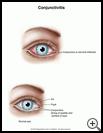
Eye Infection, Bacterial: Teen Version
What is a bacterial eye infection?
When bacteria causes an eye infection, the eye drains a yellow discharge (pus). This condition is also called bacterial conjunctivitis, runny eyes, or mattery eyes.
Your may have:
- yellow discharge in the eye
- eyelids stuck together with pus, especially after sleeping
- some redness in the white part of eyes
- puffy eyelids.
Note: A small amount of cream-colored mucus in the inner corner of the eyes after sleeping can be normal.
What is the cause?
Eye infections with pus are caused by bacteria and can be a complication of a cold. Pink eyes without a yellow discharge, however, are more common and are due to a virus.
How long does it last?
With antibiotic eyedrops, the yellow discharge should clear up in 72 hours. The red eyes (which are due to the cold) may persist for several more days.
How can I take care of myself?
- Cleaning the eye
Before putting in any medicines, remove all the pus from your eye with warm water and wet cotton balls. Unless this is done, the medicine will not have a chance to work.
- Antibiotic eyedrops or ointments
Bacterial conjunctivitis must be treated with an antibiotic eye medicine prescribed by your healthcare provider.
If your healthcare provider has prescribed antibiotic eyedrops, put 2 drops in each eye every 4 hours while you are awake. Do this by gently pulling down on your lower lid and placing the drops there. As soon as the eyedrops have been put in the eyes, close them for 2 minutes so the eyedrops will stay inside. Continue the eyedrops until you have awakened 2 mornings in a row without any pus in your eyes.
If your provider has prescribed antibiotic eye ointment, the ointment needs to be used just 4 times a day because it can remain in the eyes longer than eyedrops. Separate your eyelids and put in a ribbon of ointment along the lower eyelid from one corner of the eye to the other. Continue until 2 mornings have passed without any pus in your eye.
- Contagiousness
The pus from the eyes can cause eye infections in other people if they get some of it on their eyes. Therefore, it is very important for you to use your own washcloth and towel. Try not to touch or rub your eyes because it can make your infection last longer. Touching your eyes also puts a lot of germs on your fingers. Rinse your hands often throughout the day to prevent spreading the infection.
When should I call my healthcare provider?
Call IMMEDIATELY if:
- Your outer eyelids become very red or swollen.
- Your eye is painful.
Call within 24 hours if:
- The infection isn't cleared up after 3 days on treatment.
- You develop an earache.
- You have other concerns or questions.
Last modified: 2009-11-23
Last reviewed: 2011-06-06

